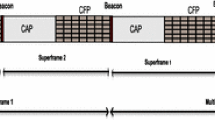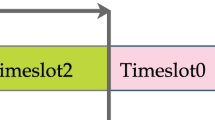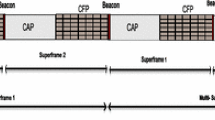Abstract
With the ongoing popularity of the IEEE 802.11 standard, many analytical studies for the distributed coordination function (DCF) have been reported but due to lack of a comprehensive model, the research has been going on. In this paper, three probabilistic analytical access delay models have been proposed for the IEEE 802.11 DCF mechanism in saturated traffic and noisy industrial applications. The first and second one provide an accurate packet delay model by solving non-linear equations at low and high Signal to Noise Ratios (SNRs) respectively. The third one on the other hand offers an approximate and simple closed-form model which does not need solving any non-linear equation and therefore can easily be utilized in the distributed adaptive network quality of service provisioning algorithms for industrial nodes which usually have limited processing capabilities. Delay-reliability, delay-packet payload and delay-data rate tradeoffs has also been studied. Simulation results match the theoretical derivations in most SNRs, confirming the effectiveness of the proposed models.













Similar content being viewed by others
References
Willig, A. (2008). Recent and emerging topics in wireless industrial communications: A selection. IEEE Transactions on Industrial Informatics, 4(2), 102–124.
IEEE. (2006). IEEE Std 802.15.4-2006, IEEE Standard for Information technology-telecommunications and information exchange between systems-Local and metropolitan area networks-Specific requirements Part 15.4:Wireless Medium Access Control (MAC) and Physical layer (PHY) Specifications for Low-Rate Wireless Personal Area Networks (WPANs).
IEEE. (2012). IEEE Std 802.11-2012, IEEE Standard for Information technology-telecommunications and information exchange between systems-Local and metropolitan area networks-Specific requirements Part 11: Wireless LAN Medium Access Control (MAC) and Physical Layer (PHY) Specifications. (Revision of IEEE Std 802.11-2007).
Bianchi, G. (2000). Performance analysis of the IEEE 802.11 distributed coordination function. IEEE Journal on Selected Areas in Communications, 18(3), 535–547.
Pack, S., Kim, K., Kim, W., Song, T., & Min, S. (2013). A cross-layer approach to reduce channel access delay jitter in IEEE 802.11 WLANs. Wireless Personal Communications, 69(4), 1379–1390.
Hasan, S. F., Siddique, N. H., Chakraborty S. (2013). Developments and constraints in 802.11-based roadside-to-vehicle communications. Wireless Personal Communications, 69(4), 1261–1287.
Ao, X., Jiang, S., & Yuan, H. (2013). Traffic-aware link rate adaptation for multi-rate 802.11 networks. Wireless Personal Communications, pp. 1–21.
Senthilkumar, D., & Krishnan, A. (2012). Enhancement to IEEE 802.11 distributed coordination function to reduce packet retransmissions under imperfect channel conditions. Wireless Personal Communications, 65(4), 929–953.
Saif, A., Othman, M., Subramaniam, S., & Hamid, N. A. W. A. (2012). An enhanced a-msdu frame aggregation scheme for 802.11 n wireless networks. Wireless Personal Communications, 66(4), 683–706.
Keene, S. M., & Carruthers, J. B. (2012). Collision localization for IEEE 802.11 wireless LANs. Wireless Personal Communications, 63(1), 45–63.
Song, W. (2011). Adaptive packetization for conversational video service over IEEE 802.11 WLANs with hidden terminals. Wireless Personal Communications, 56(3), 491–501.
Pillutla, L. S., & Krishnamurthy, V. (2011). A price based decentralized rate selection in IEEE 802.11 based WLANS. Wireless Personal Communications, 56(3), 517–534.
Ghaboosi, K., Latva-Aho, M., & Kohno, R. (2011). On a distributed cognitive MAC protocol for IEEE 802.11 s wireless mesh networks. Wireless Personal Communications, 58(3), 565–580.
Deng, D.-J., Chen, H.-C., Chao, H.-C., & Huang, Y.-M. (2011). A collision alleviation scheme for IEEE 802.11 p VANETs. Wireless Personal Communications, 56(3), 371–383.
Andreev, S., Dubkov, K., & Turlikov, A. (2011). IEEE 802.11 and 802.16 cooperation within multi-radio stations. Wireless Personal Communications, 58(3), 525–543.
Choi, Y.-J., Lee, N.-H., & Bahk, S. (2010). Exploiting multiuser MIMO in the IEEE 802.11 wireless LAN systems. Wireless Personal Communications, 54(3), 385–396.
Li, Y., Wang, C., Long, K., & Zhao, W. (2008). Modeling channel access delay and jitter of IEEE 802.11 DCF. Wireless Personal Communications, 47(3), 417–440. doi:10.1007/s11277-008-9491-4.
Khalaj, A., Yazdani, N., & Rahgozar, M. (2007). Effect of the contention window size on performance and fairness of the IEEE 802.11 standard. Wireless Personal Communications, 43(4), 1267–1278.
Anouar, H., & Bonnet, C. (2007). Optimal constant-window backoff scheme for IEEE 802.11 DCF in single-hop wireless networks under finite load conditions. Wireless Personal Communications, 43(4), 1583–1602.
Zhao, Q., Tsang, D. H. K., & Sakurai, T. (2011). Modeling nonsaturated IEEE 802.11 DCF networks utilizing an arbitrary buffer size. IEEE Transactions on Mobile Computing, 10(9), 1248–1263.
Chatzimisios, P., Boucouvalas, A. C., & Vitsas, V. (2005). Performance analysis of the IEEE 802.11 MAC protocol for wireless LANs. International Journal of Communication Systems, 18(6), 545–569. doi:10.1002/dac.717.
Raptis, P., Vitsas, V., & Paparrizos, K. (2008). Packet delay metrics for IEEE 802.11 distributed coordination function. Mobile Networks and Applications, 14(6), 772–781. doi:10.1007/s11036-008-0124-7.
Tadayon, N., Askari, E., Aïssa, S., & Khabazian, M. (2012). A novel analytical model for service delay in IEEE 802.11 networks. IEEE Systems Journal, 6(4), 627–634.
Chatzimisios, P., Boucouvalas, A. C., & Vitsas, V. (2003). Influence of channel BER on IEEE 802.11 DCF. Electronics Letters, 39(23), 1687–1689. doi:10.1049/el:20031081.
Daneshgaran, F., Laddomada, M., Mesiti, F., & Mondin, M. (2008). Unsaturated throughput analysis of IEEE 802.11 in presence of non ideal transmission channel and capture effects. IEEE Transactions on Wireless Communications, 7(4), 1276–1286.
Chen, H. (2011). Revisit of the Markov model of IEEE 802.11 DCF for an error-prone channel. IEEE Communications Letters, 15(12), 1278–1280.
Fu, J., Zhou, Z., Zheng, L., & Liu, Z. (2012). Modeling the IEEE 802.11 DCF with Hidden Stations. Springer Advances in Intelligent and Soft Computing, 143, 855–860.
Bianchi, G., & Tinnirello, I. (2005). Remarks on IEEE 802.11 DCF performance analysis. IEEE Communications Letters, 9(8), 765–767.
Tinnirello, I., Bianchi, G., & Xiao, Y. (2010). Refinements on IEEE 802.11 distributed coordination function modeling approaches. IEEE Transactions on Vehicular Technology, 59(3), 1055–1067.
Felemban, E., & Ekici, E. (2011). Single hop IEEE 802.11 DCF analysis revisited: Accurate modeling of channel access delay and throughput for saturated and unsaturated traffic cases. IEEE Transactions on Wireless Communications, 10(10), 3256–3266.
Dai, L, & Sun, X. (2012). A unified analysis of IEEE 802.11 DCF networks: Stability, throughput and delay. IEEE Transactions on Early Access Mobile Computing pp. 1–16.
Sakurai, T., & Vu, H. L. (2007). MAC access delay of IEEE 802.11 DCF. IEEE Transactions on Wireless Communications, 6(5), 1702–1710.
Karamad, E., & Ashtiani, F. (2009). Performance analysis of IEEE 802.11 DCF and 802.11e EDCA based on queueing networks. IET Communications, 3(5), 871–881. doi:10.1049/iet-com.2008.0676.
Cena, G., Bertolotti, I. C., Valenzano, A., & Zunino, C. (2007). Evaluation of response times in industrial WLANs. IEEE Transactions on Industrial Informatics, 3(3), 191–201.
Cena, G., Seno, L., Valenzano, A., & Zunino, C. (2010). On the performance of IEEE 802.11 e wireless infrastructures for soft-real-time industrial applications. IEEE Transactions on Industrial Informatics, 6(3), 425–437.
Maadani, M., Motamedi, S. A. (2011). EDCA delay analysis of spatial diversity in IEEE 802.11-based real-time wireless sensor and actuator networks. In: 8th International Symposium on Wireless Communication Systems (ISWCS), pp. 675–679.
Maadani, M., Motamedi, S. A., & Safdarkhani, H. (2011). Delay-reliability trade-off in MIMO-enabled IEEE 802.11-based wireless sensor and Actuator Networks. Procedia Computer Science, 5, 945–950. doi:10.1016/j.procs.2011.07.133.
Maadani, M., Motamedi, S. A., & Soltani, M. (2012). EDCA delay analysis of spatial multiplexing in IEEE 802.11-based wireless sensor and actuator networks. International Journal of Information and Electronics Engineering, 2(3), 318–322.
Maadani, M., & Motamedi, S. A. (2013). Spatial diversity vs. spatial multiplexing in wireless Industrial Networks; from delay and reliability perspective. Ad Hoc & Sensor, Wireless Networks Submitted, in press.
Tian, G., & Tian, Y.-C. (2012). Modelling and performance evaluation of the IEEE 802.11 DCF for real-time control. Computer Networks, 56(1), 435–447. doi:10.1016/j.comnet.2011.10.001.
Viegas, Jr. R., Guedes, L. A., Vasques, F., Portugal, P., & Moraes, R. (2012, in press). A new MAC scheme specifically suited for real-time industrial communication based on IEEE 802.11 e. Computers & Electrical Engineering.
Seno, L., Vitturi, S., & Tramarin, F. (2012). Tuning of IEEE 802.11 MAC for improving real-time in industrial wireless networks. In IEEE 17th conference on emerging technologies & factory automation (ETFA), 2012, 17–21 September 2012. pp 1–8. doi:10.1109/ETFA.2012.6489553.
Willig, A. (2008). How to exploit spatial diversity in wireless industrial networks. Annual Reviews in Control, 32(1), 49–57.
Kumarage, H., Khalil, I., Tari, Z., & Zomaya, A. (2013). Distributed anomaly detection for industrial wireless sensor networks based on fuzzy data modelling. Journal of Parallel and Distributed Computing, 73(6), 790–806.
Wang, C., Lo, H.-K., & Fang, S.-H. (2011). Fairness analysis of throughput and delay in WLAN environments with channel diversities. EURASIP Journal on Wireless Communications and Networking, 42(1), 1–14.
Aydogdu, C., & Karasan, E. (2011). An analysis of IEEE 802.11 DCF and its application to energy-efficient relaying in multihop wireless networks. IEEE Transactions on Mobile Computing, 10(10), 1361–1373.
Chatzimisios, P., & Vitsas, V. (2007). Achieving performance enhancement in IEEE 802.11 WLANs by using the DIDD backoff mechanism. International Journal of Communication Systems, 20(1), 23–41. doi:10.1002/dac.811.
(ISA) ISoA. (2009). Standard ISA100.11a-2009. Wireless systems for industrial automation: process control and related applications. ISA.
Foundation, H. C. (2010). WirelessHART, IEC 62591, System Engineering Guide, Revision 2. HART Communication Foundation.
Soltani, M. R., Motamedi, S. A., Ahmadi, S., & Maadani, M. (2011). Power-aware and void-avoidant routing protocol for reliable Industrial Wireless Sensor Networks. In: 7th international conference on wireless communications, networking and mobile computing (WiCOM), 2011, pp 1–5.
Vitturi, S., Seno, L., Tramarin, F., & Bertocco, M. (2013). On the rate adaptation techniques of IEEE 802.11 networks for industrial applications. IEEE Transactions on Industrial Informatics, 9(1), 198–208. doi:10.1109/TII.2012.2189223.
Vardakas, J. S., Sidiropoulos, M. K., & Logothetis, M. D. (2008). Performance behaviour of IEEE 802.11 distributed coordination function. IET Circuits, Devices & Systems, 2(1), 50–59. doi:10.1049/iet-cds:20070047.
Tinnirello, I., & Bianchi, G. (2010). Rethinking the IEEE 802.11 e EDCA performance modeling methodology. IEEE/ACM Transactions on Networking, 18(2), 540–553.
Hu, J., Min, G., Jia, W., & Woodward, M. E. (2012). Comprehensive QoS analysis of enhanced distributed channel access in wireless local area networks. Information Sciences, 214, 20–34. doi:10.1016/j.ins.2012.05.013.
MathWorks the matrix laboratory (MATLAB) Software. 2012b edn.
Viegas, R, Jr, Guedes, L. A., Vasques, F., Portugal, P., & Moraes, R. (2013). A new MAC scheme specifically suited for real-time industrial communication based on IEEE 802.11 e. Computers & Electrical Engineering, 39(6), 1684–1704.
Maadani, M., Motamedi, S. A., & Noshari, M. M. (2012). A reliable routing protocol for wireless vehicular networks. Journal of Intelligent Procedures in Electrical Technology (JIPET), 3(11), 64–71.
Author information
Authors and Affiliations
Corresponding author
Rights and permissions
About this article
Cite this article
Maadani, M., Motamedi, S.A. A Simple and Closed-Form Access Delay Model for Reliable IEEE 802.11-Based Wireless Industrial Networks. Wireless Pers Commun 75, 2243–2268 (2014). https://doi.org/10.1007/s11277-013-1465-5
Published:
Issue Date:
DOI: https://doi.org/10.1007/s11277-013-1465-5




